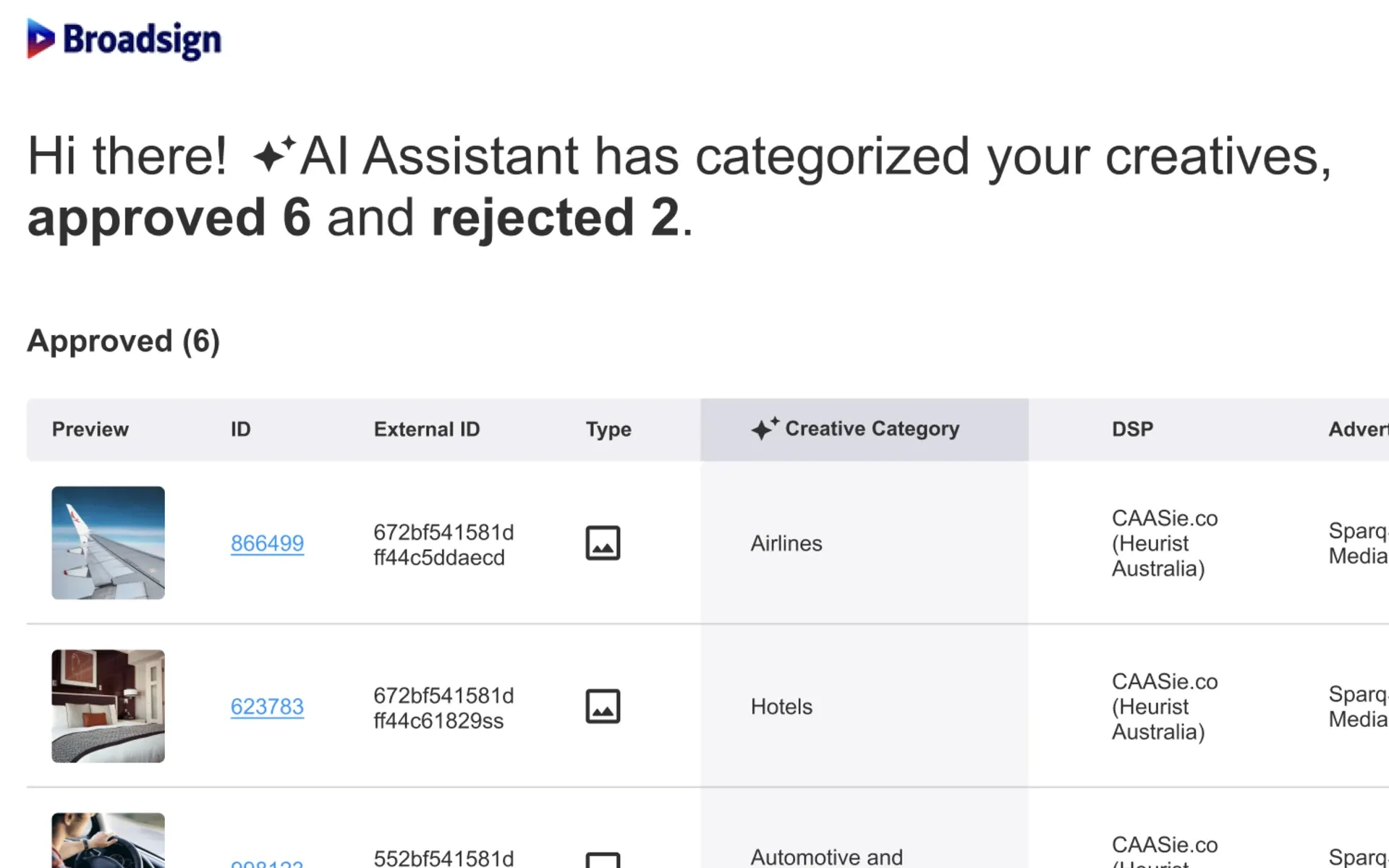Broadsign debuts AI tool for out-of-home ad creative approvals
New AI assistant aims to automate creative review process for out-of-home advertising, launching spring 2025.

Broadsign today unveiled a patent-pending artificial intelligence tool for out-of-home (OOH) advertising creative review and categorization at its annual customer summit in Barcelona. The technology addresses a significant operational challenge in the OOH industry, where media owners manually process tens of thousands of unique advertising creatives monthly.
According to Broadsign, the new AI assistant, scheduled for release in early Q2 2025, integrates directly with their Supply-Side Platform (SSP). The system analyzes incoming advertising creatives from demand-side platforms, examining technical specifications such as aspect ratio and resolution, while simultaneously detecting objects within the content to suggest appropriate categorization.
The technology leverages machine learning capabilities trained on two years of aggregated data from DSP bids received by Broadsign customers. This historical data forms the foundation for the large language model that powers the assistant's decision-making process. The system continues to adapt and refine its recommendations based on individual media owners' specific categorization and approval practices.
Media owners receive email notifications containing the AI assistant's suggestions for creative categorization and approval. The system's analysis extends beyond basic content recognition, incorporating the media owner's existing inventory taxonomy from their direct-sales operations. This integration enables cross-channel competitive separation, a crucial feature for maintaining advertising effectiveness and client relationships.
Francois Hechme, Broadsign VP of Products, stated, "Today, the manual process ties up hours of cycles evaluating creative that may not even win the bid." The statement underscores the current inefficiencies in creative review processes that the technology aims to address.
The AI assistant includes safeguards for brand safety and regulatory compliance. The system can identify potentially problematic content, such as alcohol advertisements near schools or political messaging adjacent to polling locations. This automated screening process helps media owners maintain compliance with local regulations and brand safety guidelines.
The technology's development responds to significant growth in the OOH advertising sector. Industry data indicates a 100 percent year-over-year increase in creative reviews, highlighting the escalating demand for automated solutions. This growth trajectory suggests that manual review processes may become increasingly unsustainable for media owners.
Technical implementation of the AI assistant requires integration with the Broadsign SSP and Header Bidder systems. The automation capabilities extend to various OOH advertising locations, including airports, shopping malls, retailers, health clinics, transit systems, and electric vehicle charging stations. This broad application reflects the diverse nature of modern OOH advertising environments.
The system's architecture incorporates several key technical components: creative analysis algorithms for detecting specific content elements, integration with existing taxonomy systems, and machine learning models that improve categorization accuracy over time. The AI assistant processes multiple creatives simultaneously, potentially reducing bottlenecks in the approval workflow.
Media owners retain control over the final approval decisions, with options to accept the AI's recommendations, reject them, or forward creatives for human review. This flexibility allows organizations to implement the technology according to their specific operational requirements and comfort levels with automation.
The development represents a shift in OOH advertising operations, particularly in programmatic advertising workflows. Traditional manual review processes often create delays between bid submission and campaign activation. The automated system aims to reduce these delays while maintaining necessary oversight of creative content.
Statistical analysis of current OOH operations reveals the scale of the challenge: media owners process tens of thousands of unique creatives monthly, with each requiring individual review and categorization. This volume, combined with the projected growth rate, indicates increasing pressure on manual review processes.
Implementation of the AI assistant addresses several operational challenges: reduction of misclassification errors, standardization of categorization processes, and acceleration of creative approval workflows. These improvements may enable media owners to process higher volumes of programmatic advertising requests while maintaining quality control standards.
The technology's launch timing coincides with increasing demand for programmatic OOH advertising capabilities. The system's ability to process multiple creatives simultaneously while maintaining brand safety and regulatory compliance standards positions it as a response to growing industry needs for scalable automation solutions.

